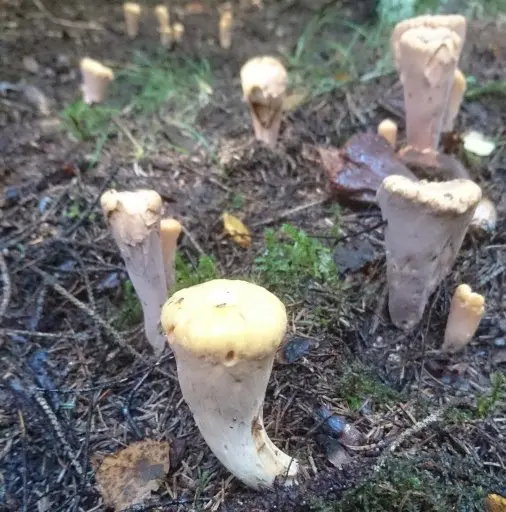Hornbill (Clavariadelphus truncatus)
- Division: Basidiomycota (Basidiomycetes)
- Subdivision: Agaricomycotina (Agaricomycetes)
- Class: Agaricomycetes (Agaricomycetes)
- Subclass: Phallomycetidae (Velkovye)
- Order: Gomphales
- Family: Clavariadelphaceae (Clavariadelphic)
- Genus: Clavariadelphus (Klavariadelphus)
- Type: Clavariadelphus truncatus
:
- Bulavastik truncated
- Clavaria truncata
- Clavariadelphus borealis

Truncated hornworm (Clavariadelphus truncatus) is a fungus belonging to the Gomph family and the Clavariadelphus genus. It is one of the types of basidiomycete fungi.
Truncated horn (Clavaria delphus truncatus) is characterized by a club-shaped fruit body, in which the apex is expanded and flattened. From top to bottom, the cap narrows, transforming into a short leg. The total height of the fruiting body is from 5 to 15 cm, and the width is from 3 to 8 cm. The surface of the fruiting body is wrinkled, painted in dark orange or yellow-ocher colors.
The leg in the lower part is weakly visible, at the base it has a slight white edge. There is a thickening of the tuberous form. The color of the mushroom pulp varies from whitish to ocher, under the influence of air (on cuts or in places of damage) it darkens, becoming brownish. It has no smell, it tastes sweet.
The hymenophore is dirty brown, more often smooth, but may also have slightly pronounced folds on its surface.
Pale buffy spores are 9-12 * 5-8 microns in size, smooth-walled, elliptical in shape.
Truncated horned (Clavaria delphus truncatus) grows right on the ground, in coniferous forests. It can be found more often in groups. The fruiting bodies of the species are often fused with each other.
Fruiting period: late summer – mid-autumn. The species is widely distributed throughout the Eurasian continent, rarely occurs. More often, the truncated horned (Clavaria delphus truncatus) can be found in the expanses of North America.
The mushroom is edible, but little studied and very rare.
Pistil horn (Clavaria delphus pistillaris) differs from the described species in its rounded upper part, and its flesh has a bitter taste.









